Crypto Surges Past $3T, BTC Hits $95K, Solana Leads DeFi Surge
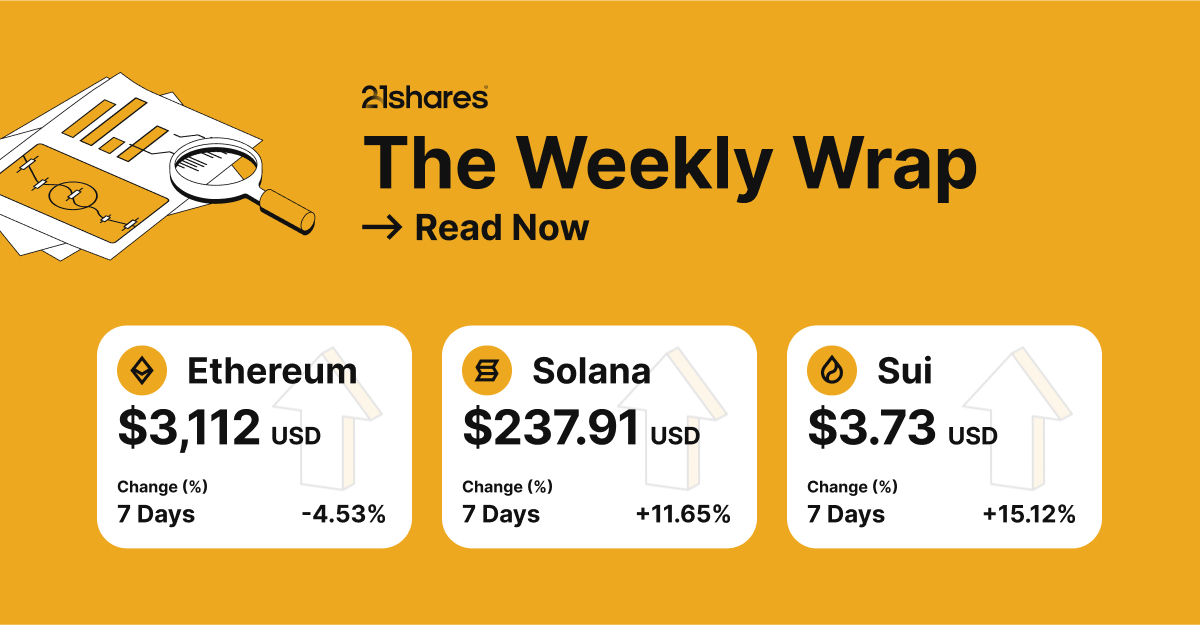


The crypto market has surged past $3T in total market capitalization, with smart contract platforms leading the charge as risk appetite expands beyond Bitcoin. In particular, lean, cost-efficient blockchains have emerged as a key driver for onboarding users and boosting on-chain activity, as reflected in Figure 1.
- Since the election, BTC is up over 38%, reaching a new all-time high (ATH) of $95,000. This price increase can be attributed to the Trump administration’s pro-stance on Bitcoin and the digital asset industry.
- Solana soared 57% since the election, driven by memecoin-fueled retail interest and unprecedented DeFi activity, generating more revenue than Ethereum.
- Ethereum is up over 28% since the election; this is largely due to Trump being a supporter of DeFi and a majority of the DeFi TVL occurring on the Ethereum blockchain.
Figure 1 – Sector Price Performance Since Election Day

Source: 21Shares, Artemis
Given the proliferation of Layer 1s (L1s), it invites a closer examination of how the industry reached this point.
- Each L1 tackled the blockchain trilemma differently. While Bitcoin and Ethereum prioritized decentralization and security, later iterations focused on optimizing scalability.
- Ethereum's first-mover advantage cemented the EVM as the standard for blockchain platforms, driving widespread adoption. However, its limitations spurred innovation, leading to the development of new virtual machines such as Solana's SVM.
Despite these differences, each Layer 1 plays a critical role in the on-chain ecosystem, tailored to unique use cases based on their architecture and features outlined in Figure 2 below.
Figure 2 – Technical Breakdown of Layer 1 Landscape

Source: 21Shares, Artemis
Below, we outline the unique strengths of each network, highlighting how they address various use cases in the order of their launch.
Ripple (XRP) - June 2012
he XRP Ledger (XRPL) is a decentralized, open-source blockchain built for fast, low-cost, and highly scalable transactions. It powers XRP, its native cryptocurrency, and supports various use cases, including cross-border payments, decentralized finance (DeFi), and tokenized assets.
- Ripple has been actively collaborating with several countries to develop Central Bank Digital Currencies (CBDCs) and stablecoins using its XRP Ledger (XRPL) technology. Notable partnerships include: the Republic of Palau, Montenegro, Bhutan, and Colombia, to name a few.
- Ripple has formed partnerships with various banks and TradFi financial institutions to facilitate cross-border payments. Notable collaborations include Santander, Standard Chartered, Mastercard, and American Express, all of which have leveraged Ripple's technology to enhance payment processing and liquidity management
- Several ETF providers have submitted S-1 filings to the SEC for a spot XRP ETF. With the Trump administration's pro-crypto stance and its push for a more favorable regulatory environment, the likelihood of these ETFs gaining approval has significantly increased—highlighting growing institutional recognition and adoption of XRP as a mainstream asset.
Ethereum (ETH) - July 2015
The leading platform for decentralized applications (dApps) and a pioneer in smart-contract technology, as the first blockchain to introduce smart contracts.
- Ethereum laid the foundation for dApps and DeFi, commanding the highest liquidity with a Total Value Locked (TVL) of $60B.
- Its focus on decentralization and security, with more than 1M validators, makes it a trusted platform for tokenized government securities, totaling over $1.5B in assets.
- Ethereum hosts over 4,000 dApps, including prominent DeFi platforms like Uniswap and Aave, leveraging its unmatched network effects as the most widely adopted blockchain. While Layer 2 solutions enhance speed and efficiency, they have also introduced fragmentation, leading to reduced revenue. Coinbase Wallet’s upcoming 'tap-to-pay' solution aims to provide a seamless global payment experience, fostering a more cohesive ecosystem.
Cardano (ADA) - September 2017
The platform sets itself apart with a rigorous, research-driven approach to blockchain development.
- Introduced formal verification for smart contracts and enhanced Ethereum's Proof-of-Stake (PoS) with Delegated Proof of Stake (DPoS), democratizing transaction validation.
- Collaborates with governments like Ethiopia to deploy Atala PRISM, enabling digital IDs that improve access to education and financial infrastructure in underserved regions. The network also promoted a transparent and efficient aid-distribution system.
- Cardano’s growth has been hindered by slow development, a lack of EVM compatibility, and the absence of on-chain governance, resulting in a modest $456M TVL. Recent upgrades like the Chang Hard Fork foster a community-driven network, while BitcoinOS integration will boost cross-chain utility by facilitating ADA-powered Bitcoin transactions.
Solana (SOL) - March 2020
The network adopted a distinct approach, prioritizing scalability powered by their innovative dual consensus model combining Proof of History (PoH) and PoS. With the ability to process nearly 3,000 transactions per second (TPS), Solana stands as one of the fastest blockchains available.
- This month, Solana’s DEX trading volume exceeded Ethereum’s by $40B, fueled by its efficient, low-cost blockchain and propelled by a dynamic DeFi ecosystem rich in retail-driven activity. This surge in trading volume has been a key driver behind the growth in Solana's TVL, now reaching $8.3B.
- Solana powers decentralized physical infrastructure networks (DePIN) like Helium (broadband), Hivemapper (mapping), and Render (3D rendering), which demand high-speed, low-cost transactions at scale. Solana’s fast and efficient blockchain provides the necessary infrastructure for these applications to operate smoothly and cost-effectively.
- For Solana to deepen its integration with traditional finance—supported by PayPal’s PYUSD, which processes $30B, along with partnerships with Visa and Shopify—it must address ongoing network reliability issues, especially as its network experienced downtime once this year and multiple times over the past three years. The Firedancer validator client, capable of over 1M TPS on testnet, is positioned to reduce outages and enhance reliability, solidifying Solana’s role as a top solution.
Polkadot (DOT) - March 2020
Polkadot is a Layer 0 blockchain platform designed to enable interoperability and scalability by connecting multiple Layer 1 blockchains, or parachains, within its ecosystem. Powered by its native token DOT, Polkadot facilitates secure data and asset exchanges across diverse networks while providing the foundation for building customizable and collaborative blockchain applications.
- The network was founded by Dr. Gavin Wood, a co-founder of Ethereum and the visionary architect behind Ethereum's infrastructure, including its Solidity programming language. As Ethereum's former CTO, Wood played a pivotal role in shaping the blockchain's foundation before launching Polkadot to address scalability and interoperability challenges that existing blockchains faced. His expertise and innovation have positioned Polkadot as a groundbreaking Layer 0 network, advancing the multi-chain future of Web3.
- Polkadot boasts a robust network of parachains, specialized blockchains optimized for specific use cases, all seamlessly connected through its shared Layer 0 infrastructure. These parachains are built using Polkadot Substrate, an open-source, modular framework that serves as the development toolkit for creating interconnected blockchains within the Polkadot network. With over 150 projects leveraging Substrate to build applications across DeFi, NFTs, gaming, and more, Polkadot has established itself as a thriving ecosystem for blockchain innovation and collaboration.
Aptos - October 2022
High-performance blockchain leveraging the Move programming language, which was developed by Meta for their Diem project. Move prioritizes security and scalability, making it a strong contender for institutional use cases.
- Parallel processing enables sub-second settlement times and a theoretical throughput of 160,000 TPS, ensuring the performance needed for enterprise-grade applications.
- Aptos, led by ex-executives of Meta's Diem project, is bringing institutions on-chain. Its credibility is bolstered by partnerships with TradFi giants like Microsoft, Franklin Templeton, and NBC Universal, alongside institutional-grade use cases such as Ondo’s tokenization platform. Alongside a growing DeFi ecosystem, which we’ll explore in detail later, these efforts have propelled its TVL to nearly $1B.
- Aptos streamlines Web3 access with keyless accounts, passwordless authentication, and transaction previews. Its support for emerging markets includes cost-efficient devices like the Jambo Phone, preloaded with blockchain tools. By combining advanced scalability with user-first design, Aptos is well-positioned for this cycle.
Sui - May 2023
Aptos’ twin is also a high-performance blockchain designed to deliver Web2-like simplicity to Web3. Also built on the Move programming language, it focuses on consumer-facing applications rather than institutional use cases.
- Sui caters to retail users with innovations like SuiPlay0X1, a gaming device bridging Web3 and traditional gaming. This focus has positioned Sui as a leader in consumer-facing dApps.
- Sui pairs sub-second finality and parallel processing with intuitive features like zkLogin for wallet creation via Google or Face ID, gasless interactions covered by apps, and QR-based payments with zkSend. By combining scalability with a user-friendly experience, Sui is primed to drive retail adoption and bridge the gap between Web2 and Web3, onboarding the next generation of crypto users.
- The recent launch of its Ethereum bridge and USDC support has significantly boosted Sui’s DeFi ecosystem, driving its TVL beyond $1.5B. This growth aligns with Sui’s recent ATH, just shy of $4.
Key Metrics
We've just highlighted each blockchain's unique features and selling points; now, let's examine how these translate into real on-chain activity. We'll assess key metrics like active addresses, DEX trading volume, fees generated, and total value locked (TVL) to provide a clearer picture of each network's performance.
Daily Active Addresses
Figure 3 – Daily Active Addresses

Source: 21Shares, Artemis
As shown in Figure 3 above, Solana emerged as a forerunner in user engagement, boasting the largest user base of 6.5M users driven by its trifecta of low fees, rapid transactions, and a user-friendly interface. A perfect storm for the memecoin frenzy that swept through the network this year, with more than 3.5M tokens launched on the memecoin factory pump.fun alone. Furthermore, Solana has become the preferred platform for the latest crypto trends, including tokens tied to AI-powered agents and DePIN protocols. Notably, for DePIN, Solana has solidified itself as the premier platform, hosting dominant use cases across various sectors. These include distributed computing (IONET, Render), decentralized broadband (Helium), decentralized mapping (HiveMapper), and community-governed scraping services (Grass), which are crucial for feeding data into AI models.
Similarly, Aptos has shown impressive user growth compared to other L1 blockchains like Avalanche, driven by its expanding DeFi ecosystem. Key developments fueling momentum include Blackrock's BUIDL product expansion, the deployment of Tether’s USDT and Circle’s USDC on the network, and the upcoming integration of sBTC by Stacks. Together, these advancements are driving increased user enthusiasm and engagement across the network.
Ethereum, however, remains a formidable player, having effectively shifted a significant portion of its activity to L2 scaling solutions. This has resulted in almost 90% of transactions now occurring on L2s rather than the mainnet, underscoring the growing importance of scaling solutions as the execution layer for the legacy network. Despite this, L2s solutions have dramatically expanded Ethereum's capabilities, achieving a 26-fold increase in throughput —382 transactions per second (TPS) compared to 14 TPS on the base layer—and attracting a user base of 2.6M, more than seven times Ethereum's mainnet average of 350K users.
DEX Volume
Figure 4 – Decentralized Exchange (DEX) Trading Volume on Smart-Contract Platforms in 2024
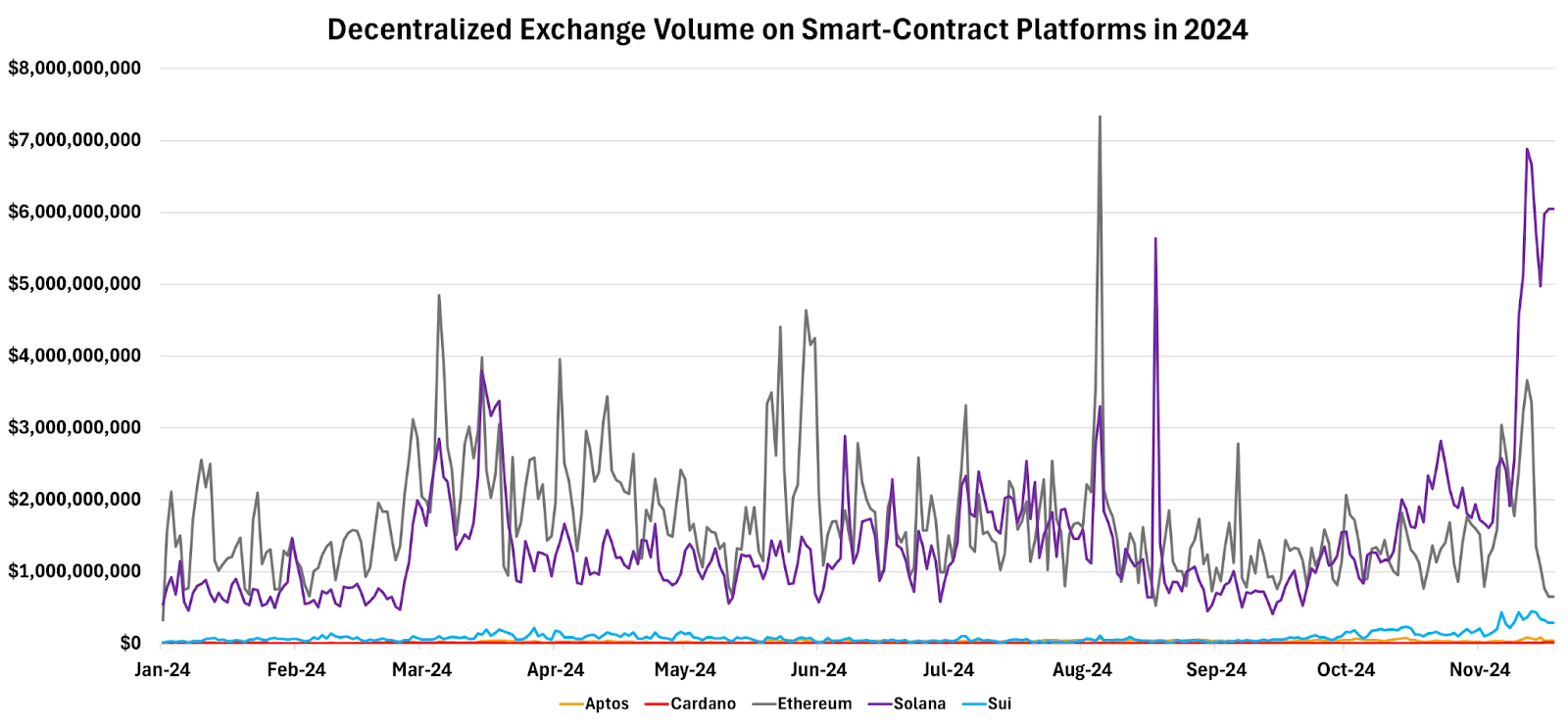
Source: 21Shares, Artemis
From a broader perspective, Ethereum and Solana dominate exchange activity, fueled by their thriving DeFi ecosystems. Ethereum has long maintained its top position, with the largest DeFi ecosystem boasting nearly $60B in TVL. Its financial applications have demonstrated remarkable resilience, withstanding multiple market challenges since 2020. In addition, Ethereum has been contributing almost 50% of all DEX volume through the first three quarters of the year, until Solana flipped the script, as illustrated in Figure 4.
In fact, Solana has recently outpaced Ethereum across multiple metrics. For example, Solana’s DEX trading volume exceeded Ethereum’s by $40B in November, while its weekly DEX trading volume eclipsed Ethereum and all its Layer 2s combined during the final week of October. Additionally, three out of the top ten revenue-generating applications now operate on the Solana network. Notably, the Solana-based DEX Radyium generated $29B in trading volume over the last week, a 45% difference compared to Uniswap’s $20B. Furthermore, Solana-based platforms now account for three of the top ten DEXs, commanding over 40% of the total 24-hour trading volume across the entire crypto ecosystem.
While Polkadot and Ripple may not have a robust decentralized exchange (DEX) ecosystem compared to some other blockchain platforms, they excel in other critical areas that highlight their unique strengths. Polkadot boasts a thriving developer community fueled by its open-source Substrate framework, enabling innovation across a wide range of industries with hundreds of projects building within its ecosystem. Ripple, on the other hand, demonstrates strength through its key institutional partnerships, including collaborations with central banks and major financial institutions to advance cross-border payments and CBDC development. These attributes position both platforms as leaders in driving blockchain adoption and innovation in their respective domains.
Fees
Figure 5 – Daily Fees
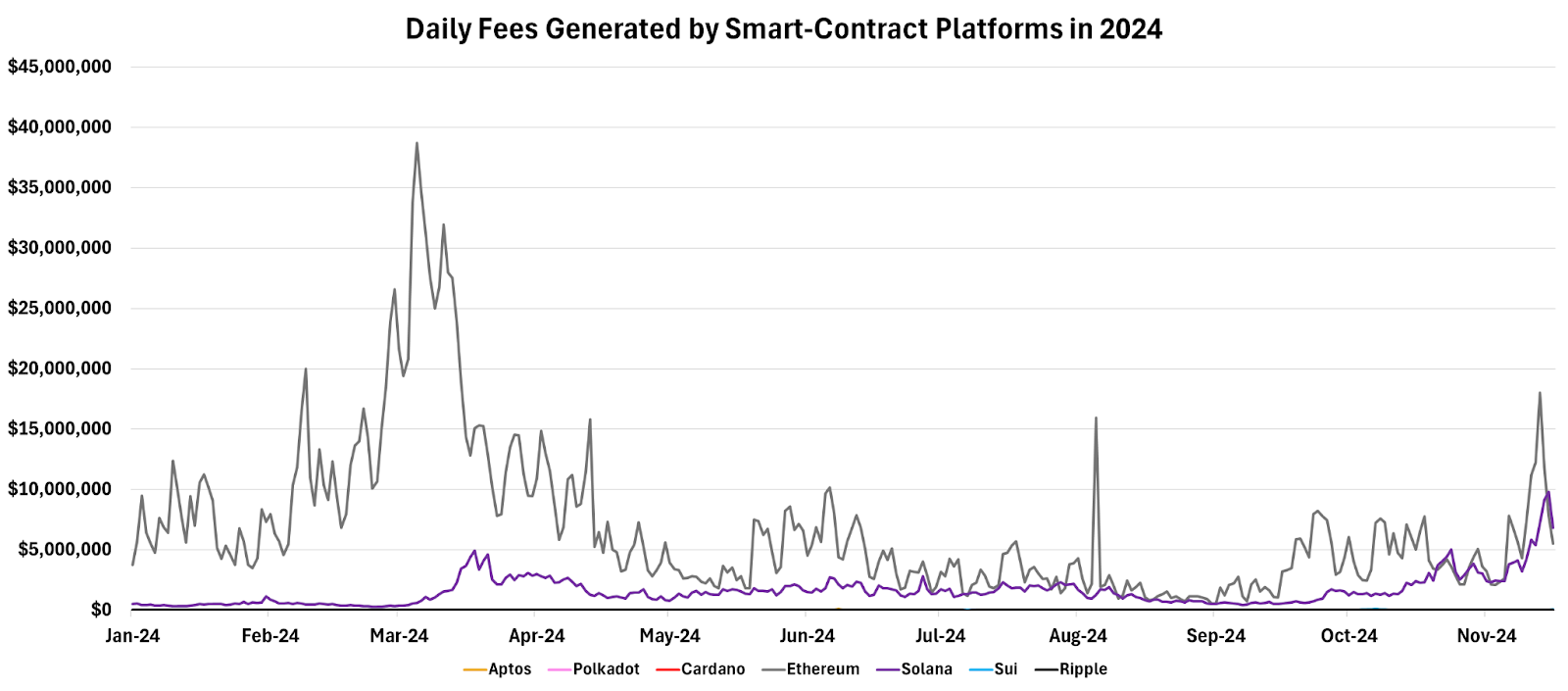
Source: 21Shares, Artemis
Solana is the king of alt-layer 1s with respect to fees. It has established itself as a fee-generating powerhouse, as depicted above in, figure 5 with many leading dApps leveraging its high-speed, cost-effective blockchain. For example, the no-code memecoin creator platform Pump.fun has generated $220M in fees and attracted 150K users. Moreover, Solana-based protocols account for 50% of the top 15 fee-generating applications across all blockchains. Notably, trading bots Photon and BonkBot earn a combined $75M monthly, while Radium and staking provider Jito contribute $300M, collectively. This positioned Solana to currently generate 110% of Ethereum's real economic value.
However, year-to-date, Ethereum is the undisputed king in fees generated. Ethereum's recent Dencun upgrade led to a 90% reduction in L2 transaction costs. The upgrade introduced blobspace, an efficient data storage mechanism for L2 solutions. As this new system gains traction and approaches capacity, L2 transaction costs will gradually increase. This trend, already becoming apparent as shown below in Figure 6, suggests a potential resurgence in Ethereum's mainnet revenue in the coming months.
Figure 6 – Ethereum Average Blob Count Per Block

Source: 21Shares, Dune Analytics
TVL
Figure 7 – Total Value Locked
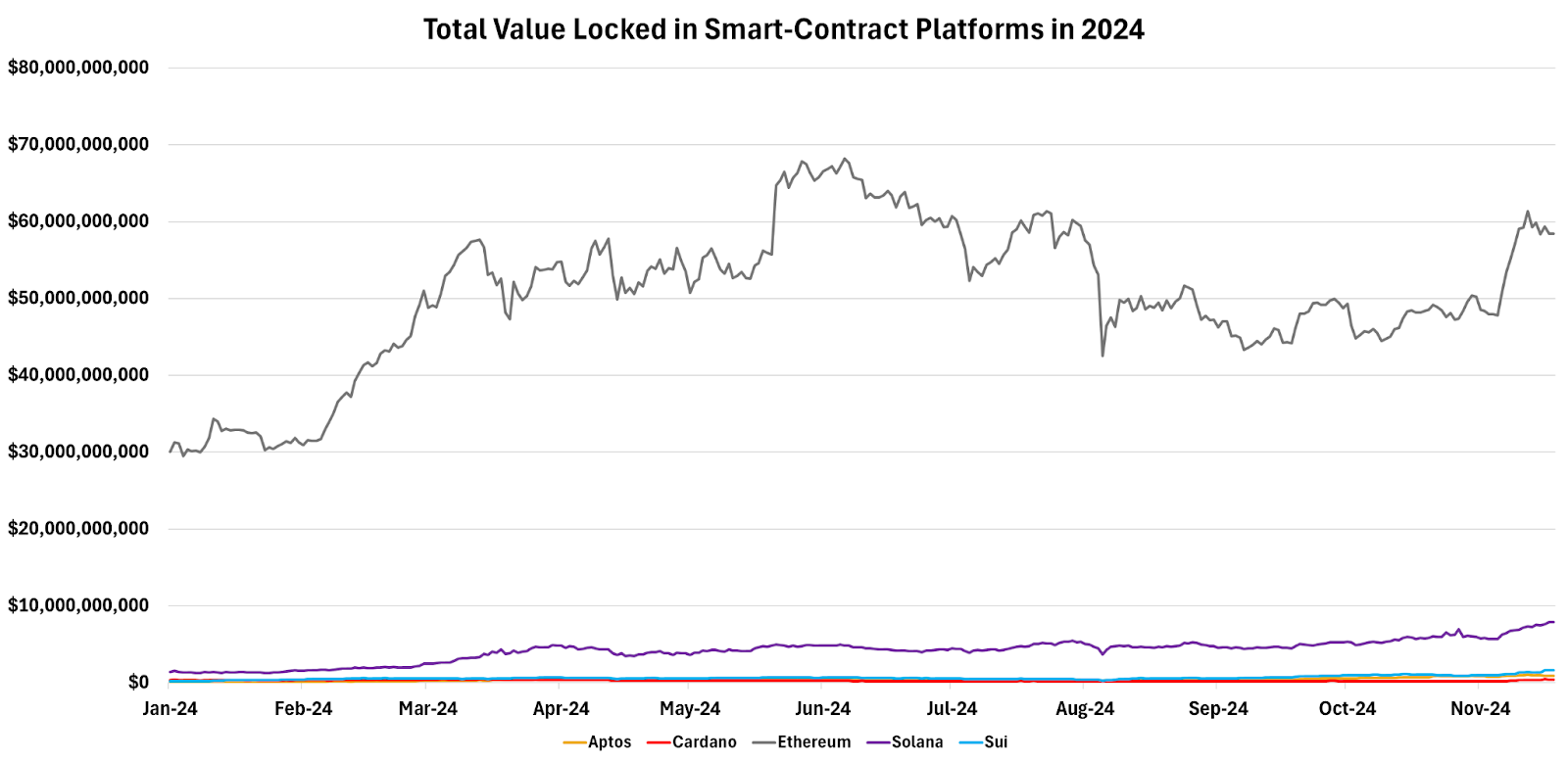
Source: 21Shares, Artemis
To recap, TVL serves as a crucial metric for financial ecosystems in the crypto space, analogous to Assets Under Management (AUM) in traditional finance. Ethereum, as the pioneer of DeFi, unsurprisingly maintains the largest TVL among all networks. However, the landscape is evolving rapidly.
Solana has emerged as a significant player, now commanding nearly 10% of DeFi's total TVL. This growth can be attributed to its seamless integration with traditional finance (TradFi), expanding tokenization sector, and proliferation of payment-related use cases, as well as the surging maturity of its DeFi ecosystem that we’ve already covered throughout the report.
In conclusion, these metrics provide a comprehensive view of the current standing and performance of various layer-1 blockchains. As seen in figure 8, these platforms illustrate the diversity in blockchain usage patterns and provide insight into how each chain is positioned to compete in the landscape of blockchain-based applications. We believe there will not be “one chain to rule them all” and instead we will see a multi-chain future where certain chains are used over others for specific use cases.
Figure 8 – Summary of Key Metrics Across Smart-Contract Platforms

Source: 21Shares, Artemis
What’s also happening this week?
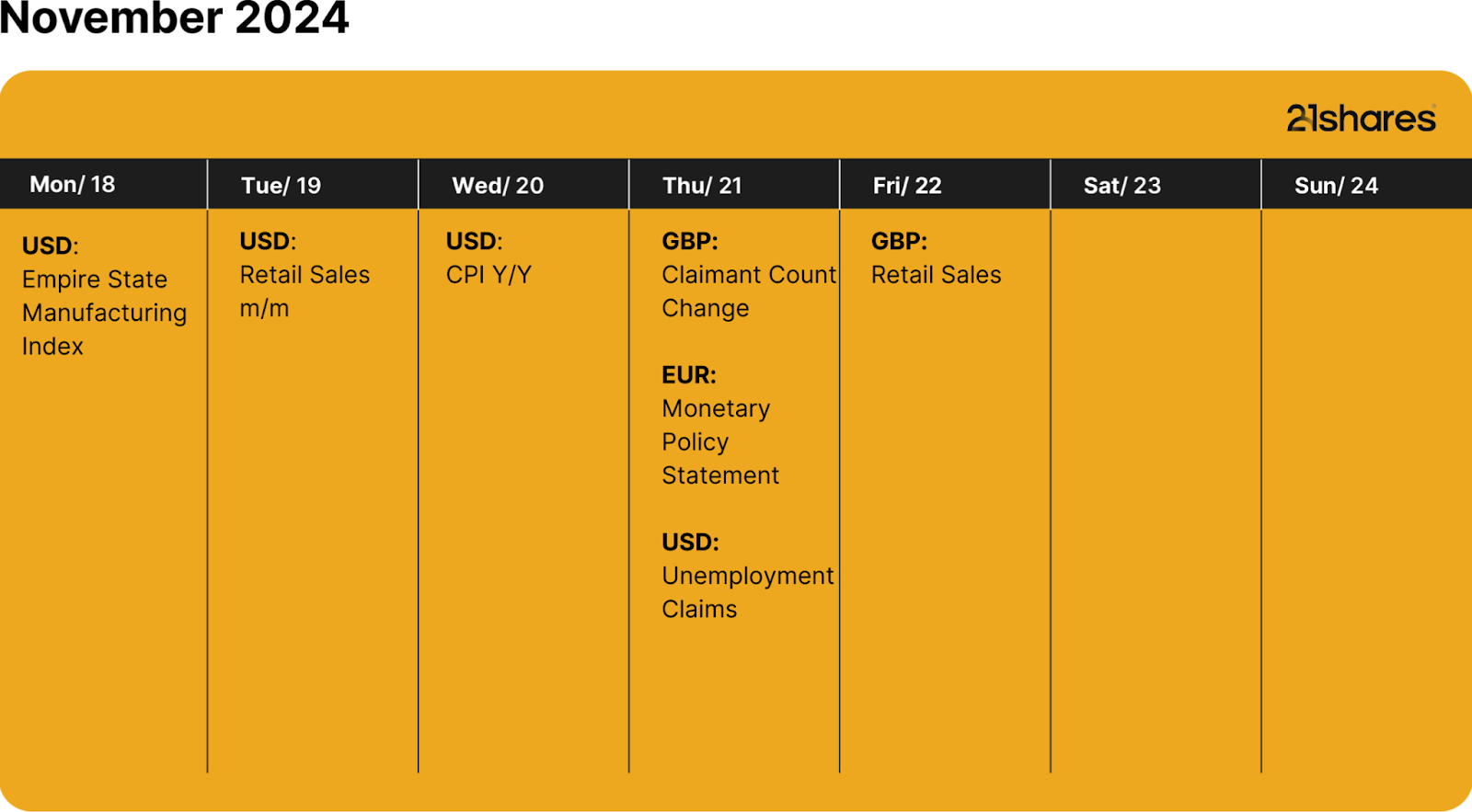

.jpg)





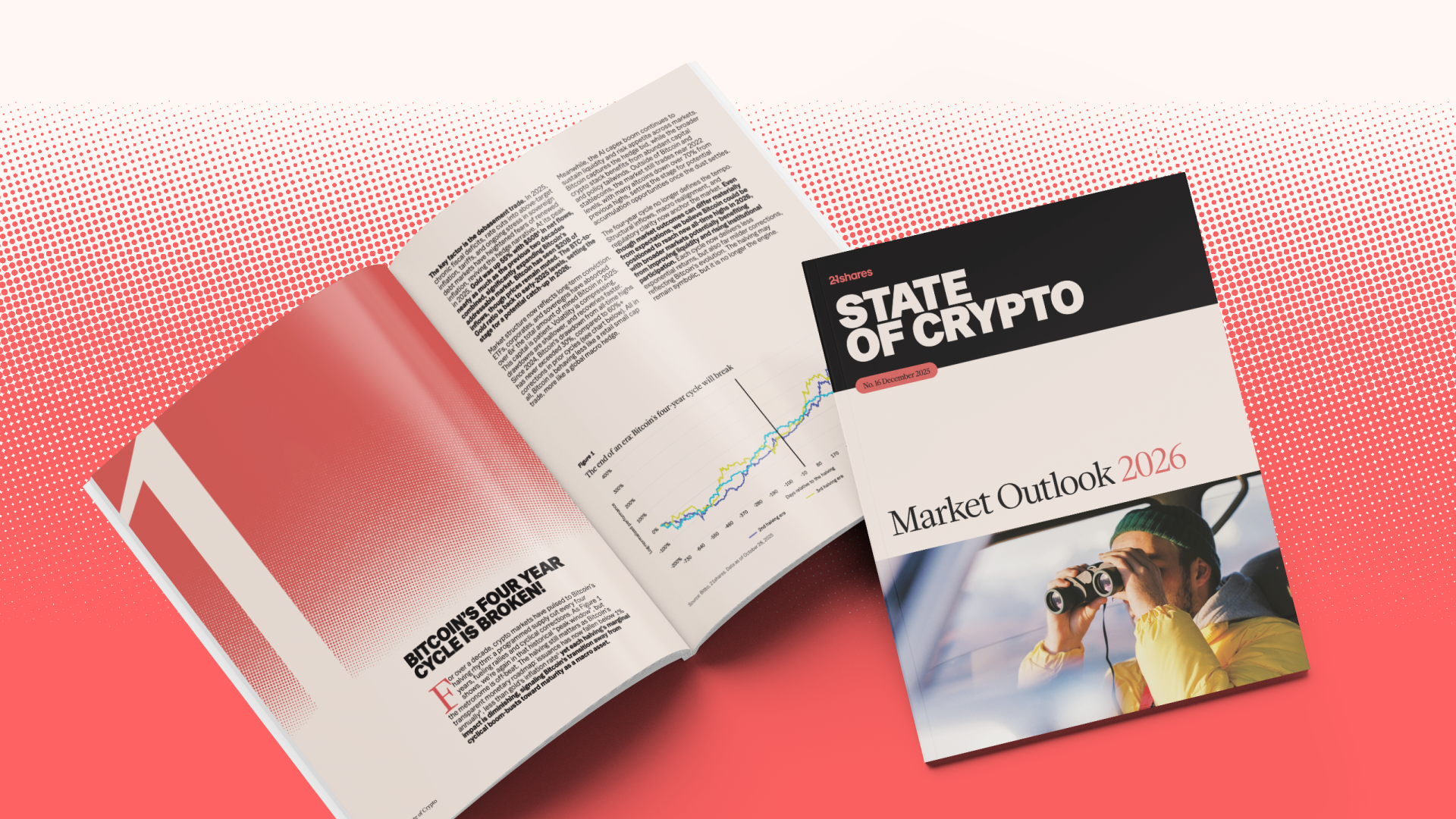

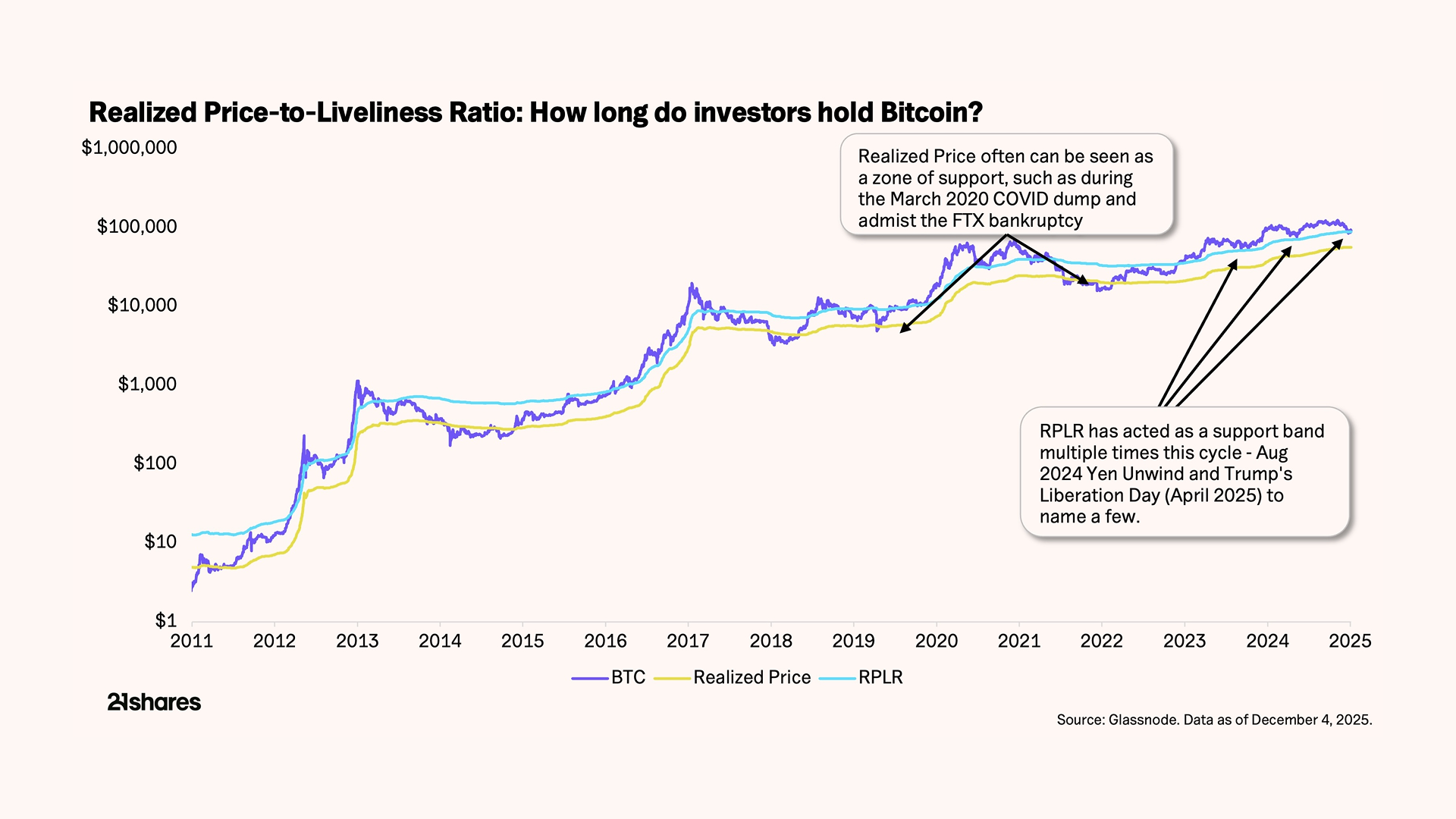
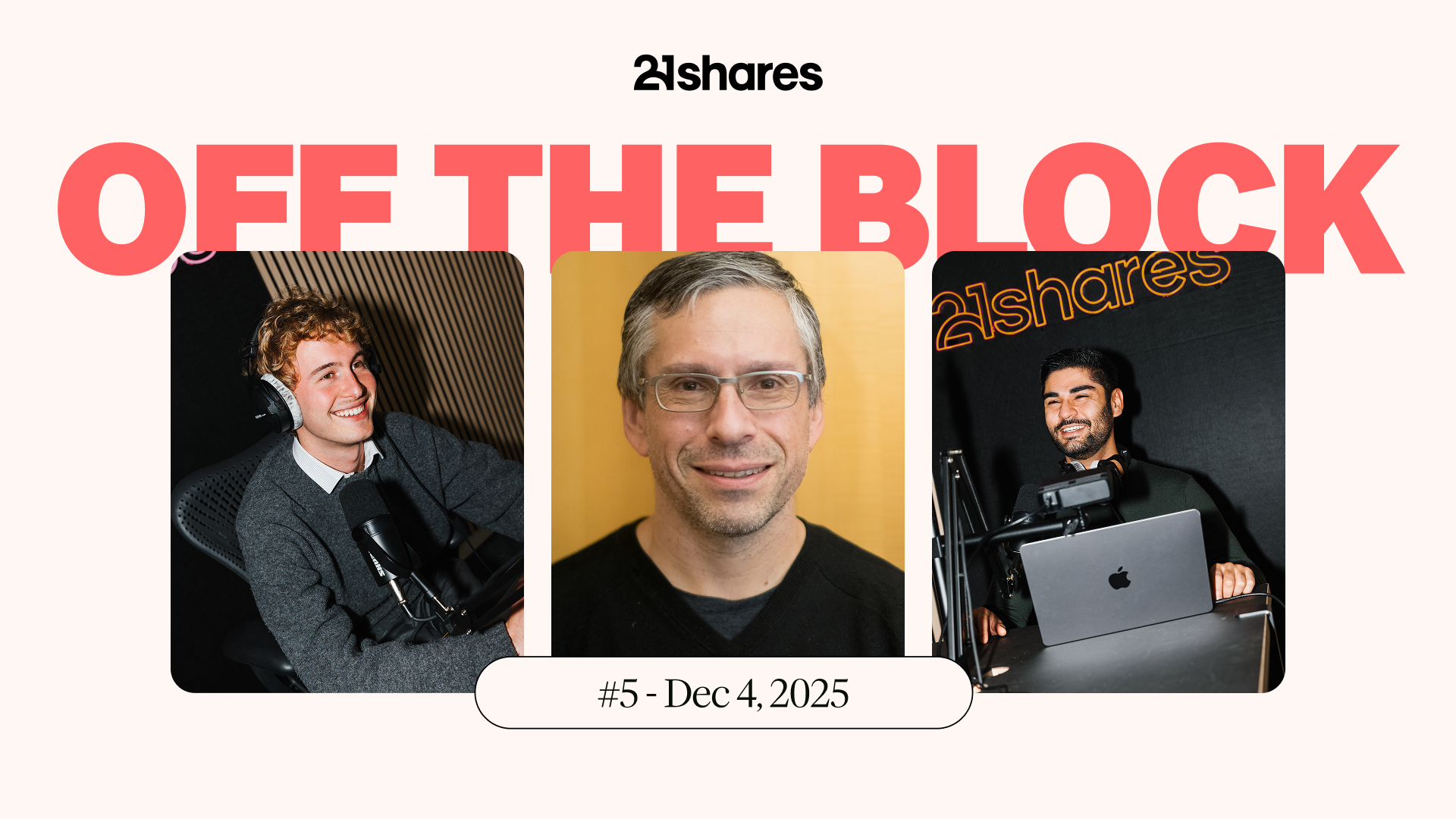

.svg)



_logo.svg)

.svg.png)